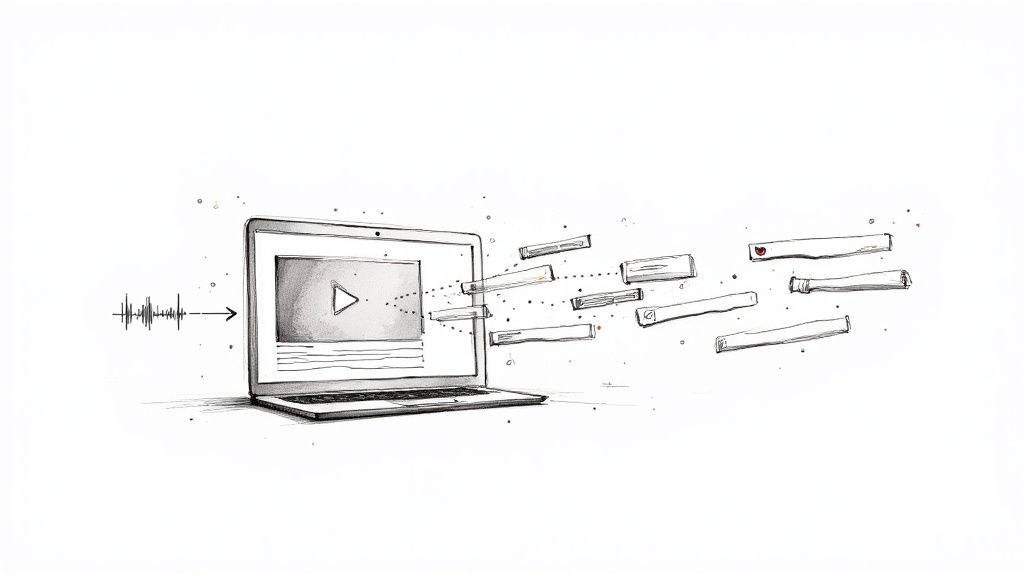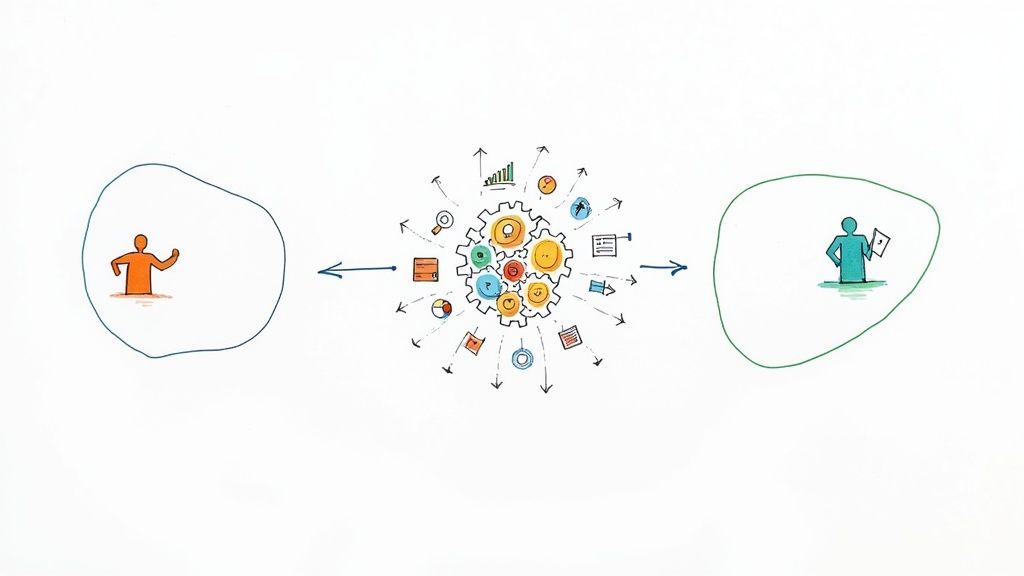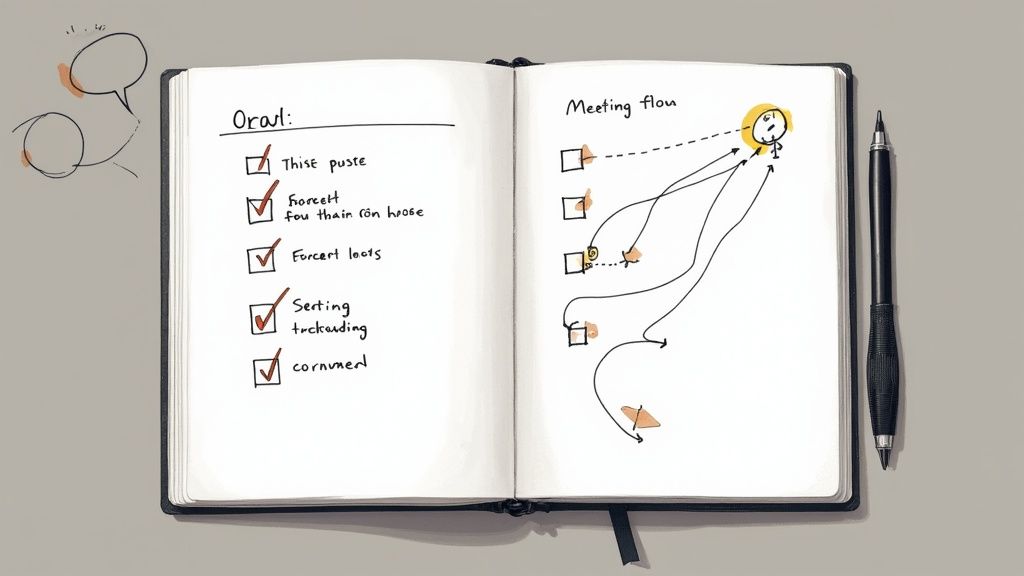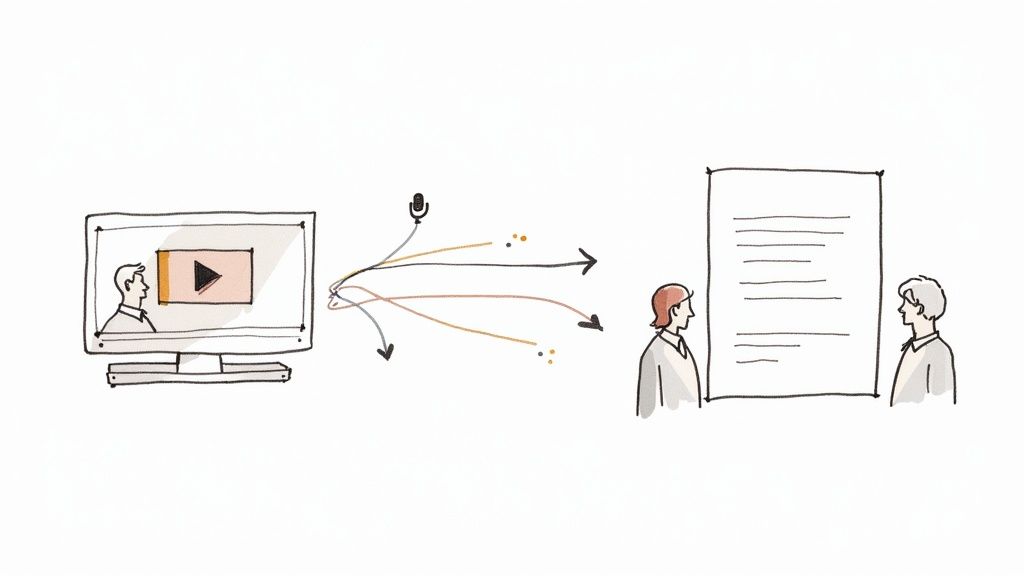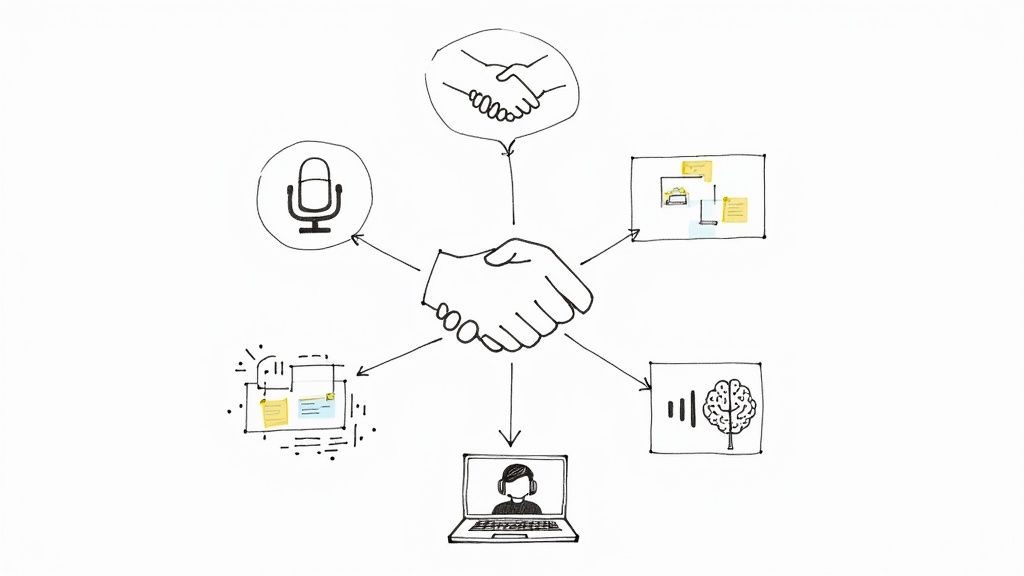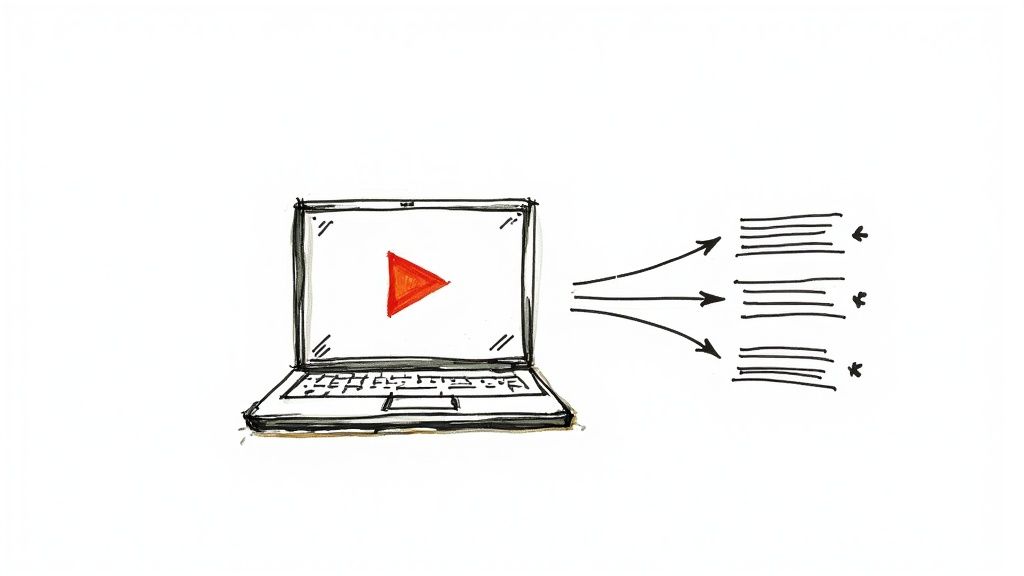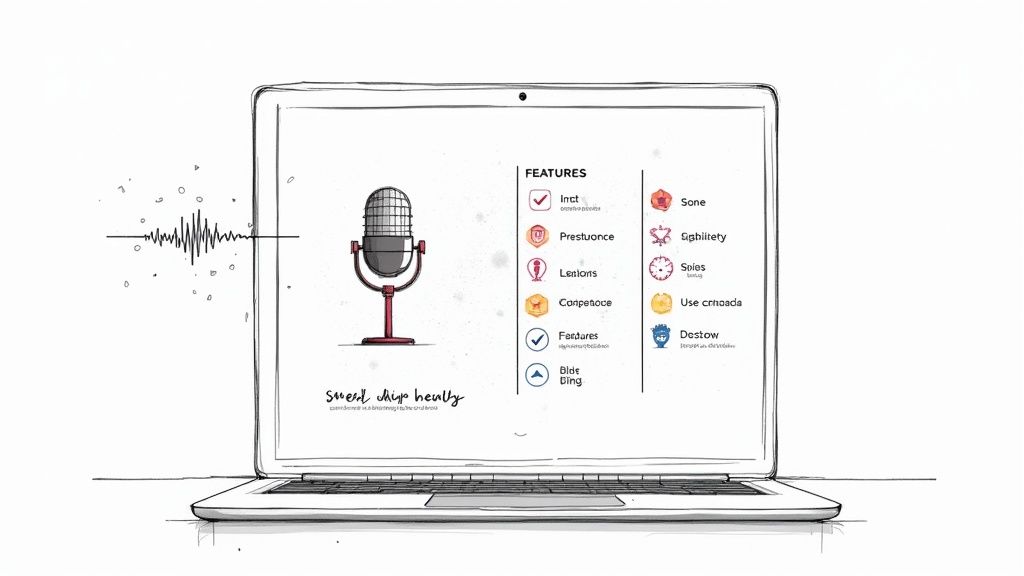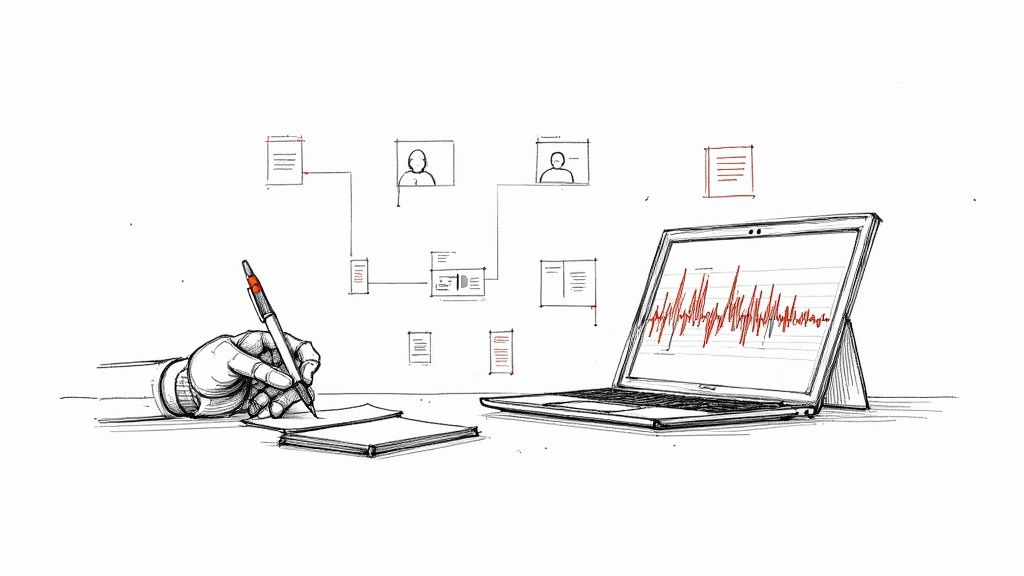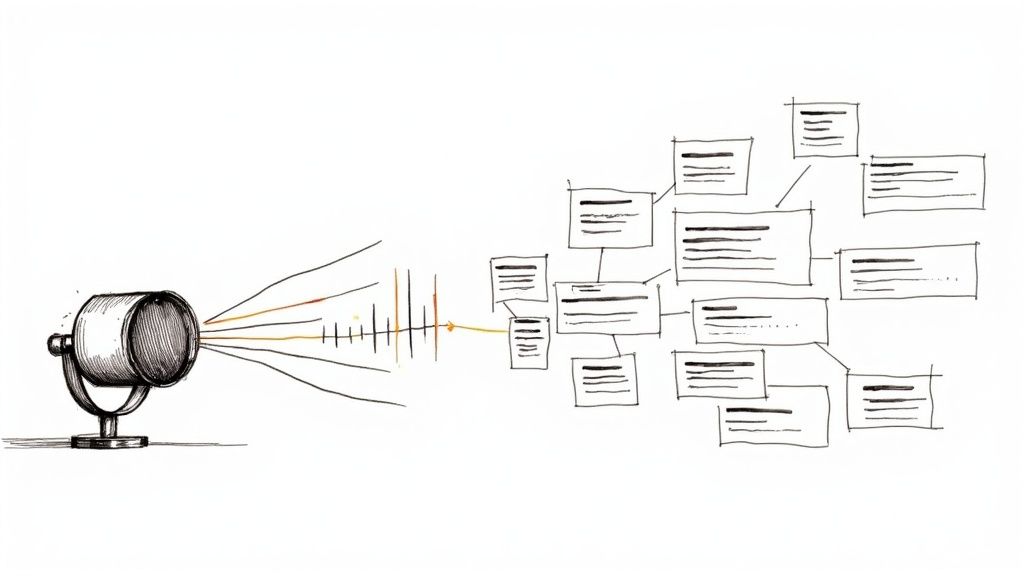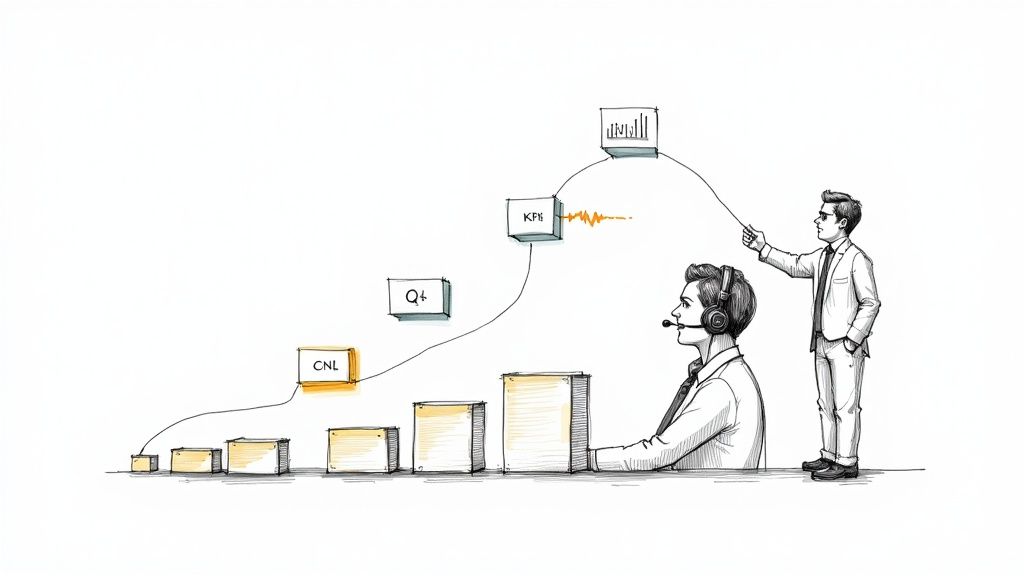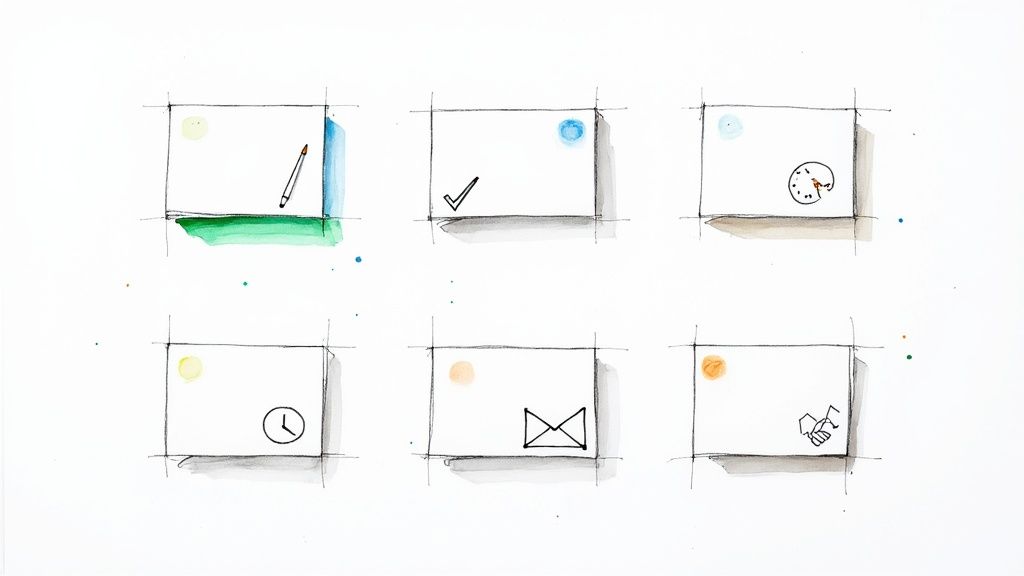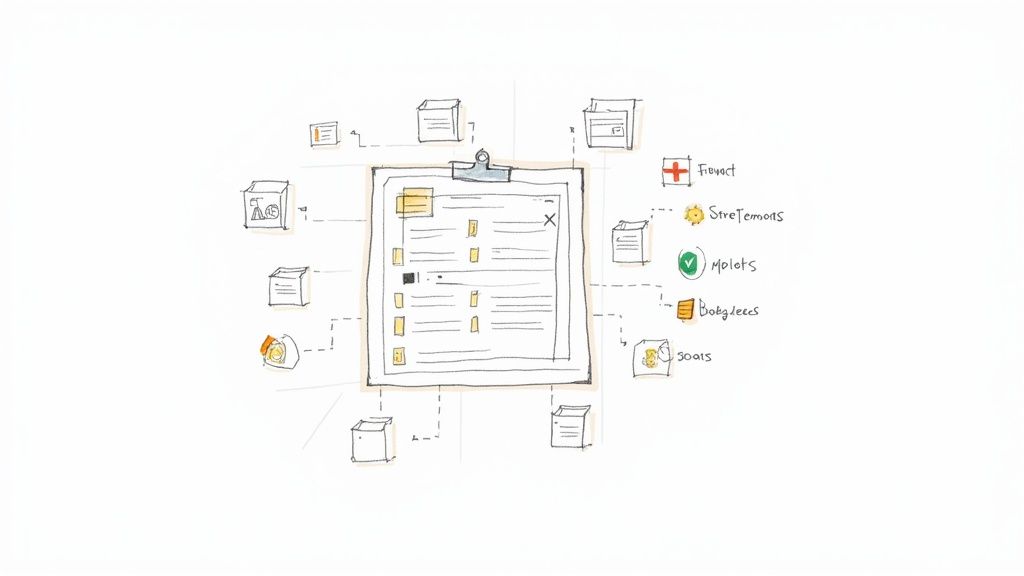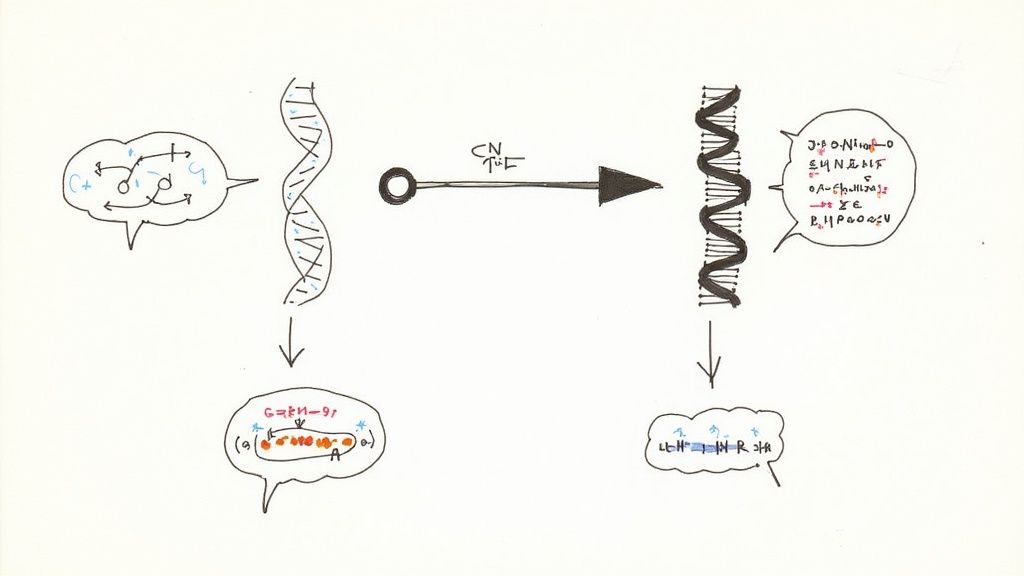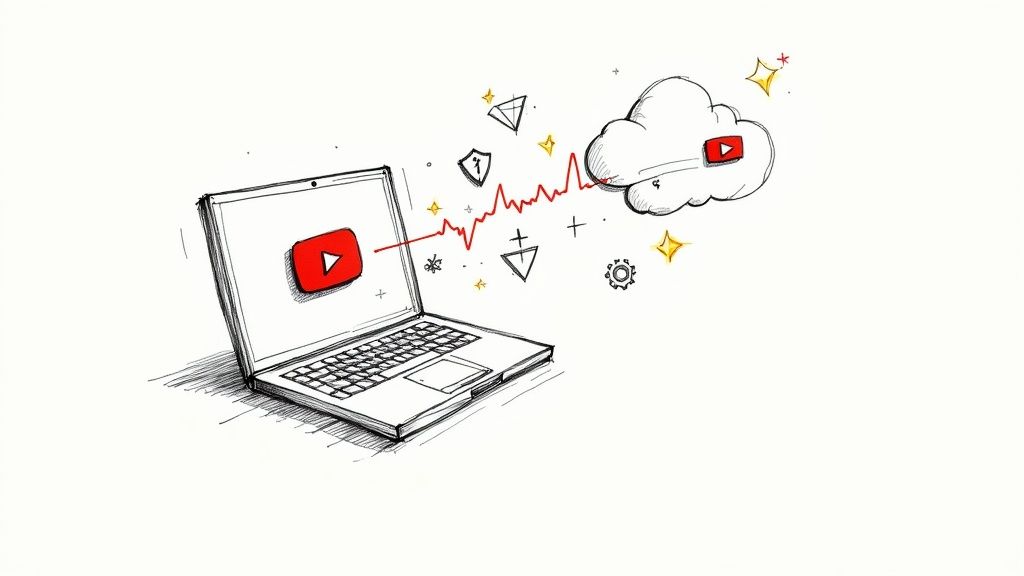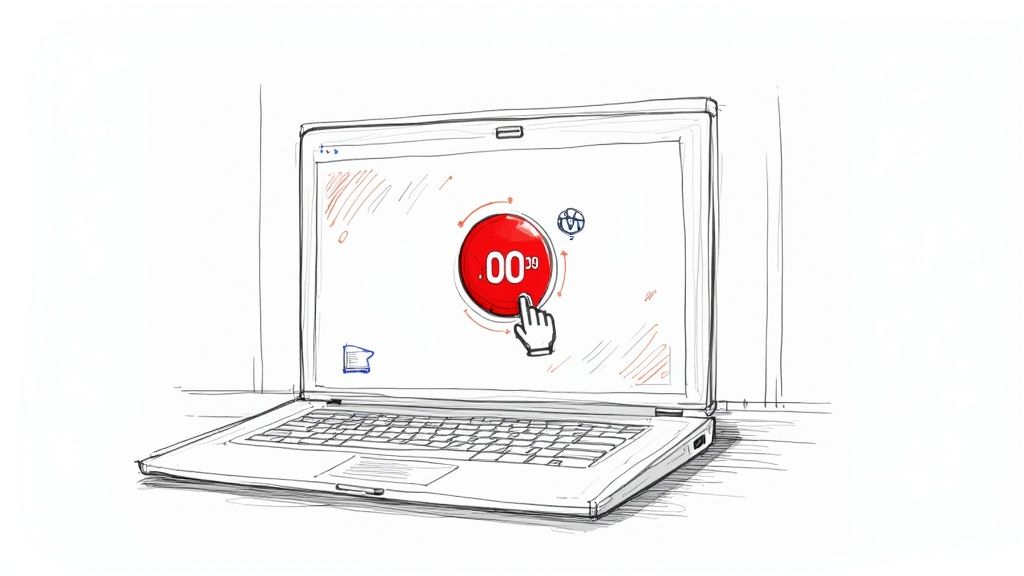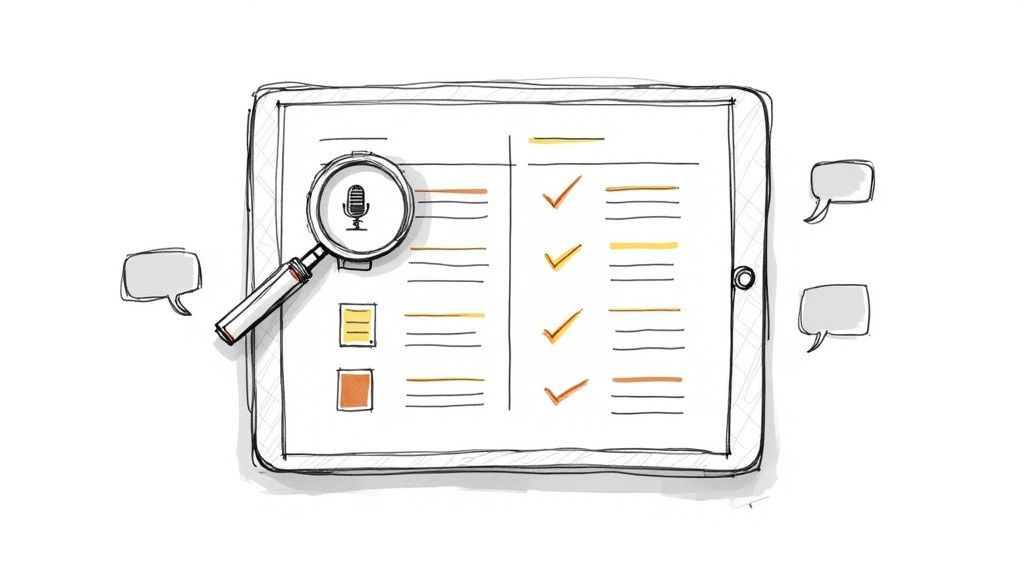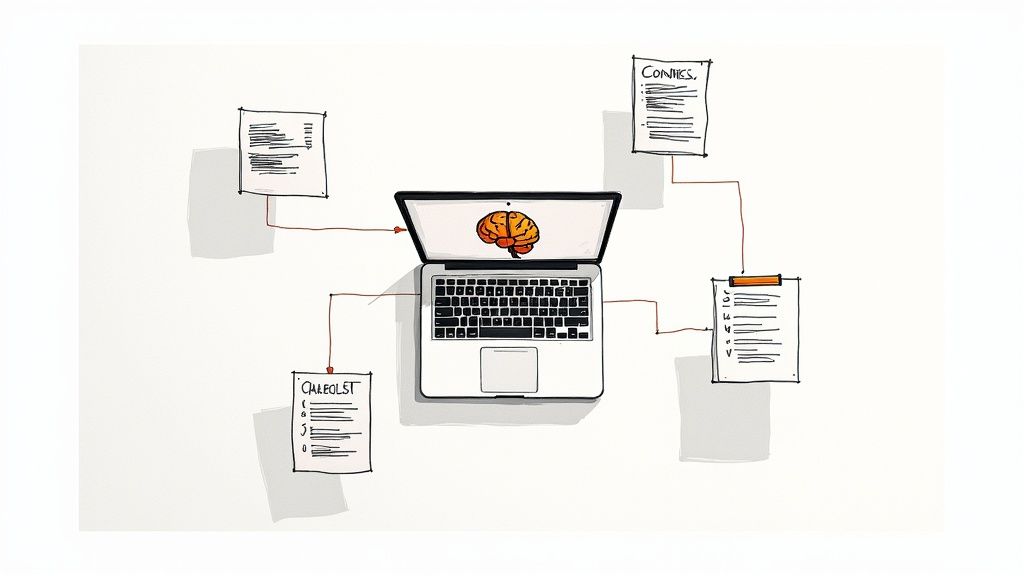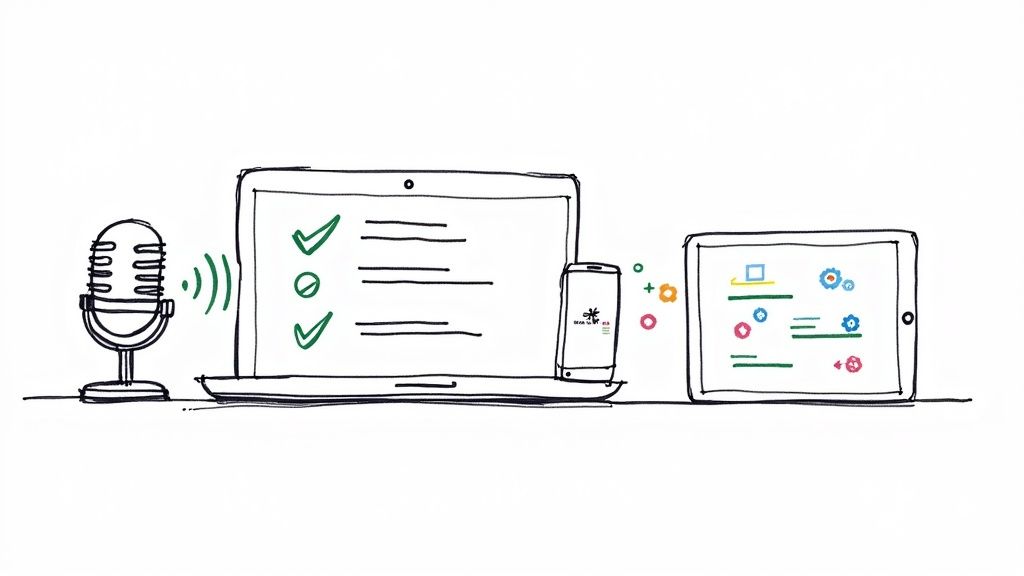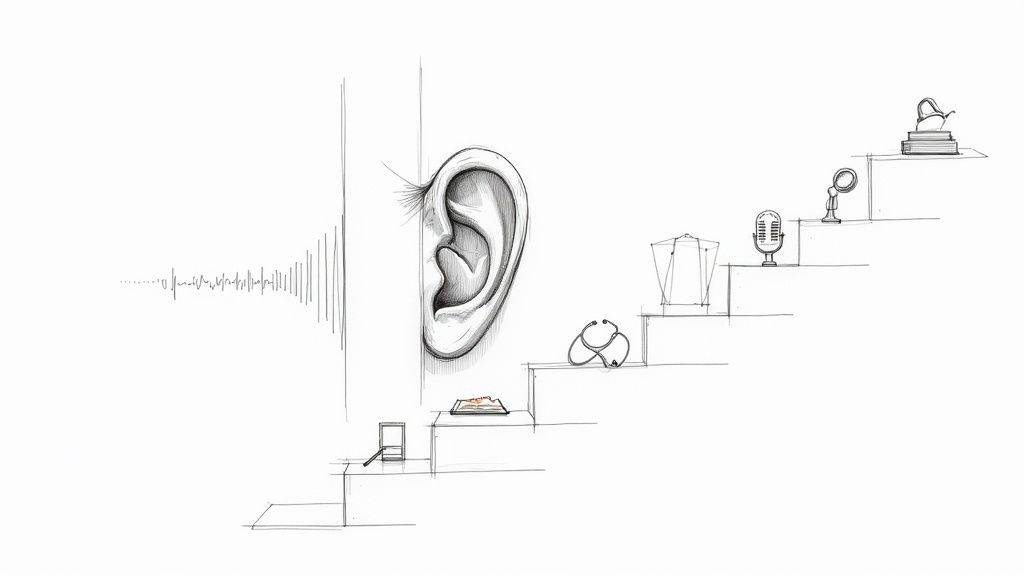10 Proven Content Repurposing Strategies to Maximize Your Reach
You've invested significant time and effort into creating a stellar piece of content—a comprehensive blog post, an engaging webinar, or a deep-dive podcast episode. After hitting publish, the crucial question is: what's next? Letting that valuable asset gather digital dust is a missed opportunity. The key to amplifying your reach and impact isn't just creating more content; it's about being more strategic with the content you already have.
This is where content repurposing comes in. From my experience, it’s not about cutting corners; it’s about working smarter to maximize the return on your initial investment. By intelligently adapting one core asset into multiple formats, you can connect with different audience segments on their preferred platforms, reinforce your core message, and significantly boost your brand's visibility. This approach transforms a single publication into a sustained, multi-channel campaign, ensuring every piece of hard-earned insight delivers lasting value.
This guide provides a playbook of ten actionable content repurposing strategies I've personally seen deliver results. We'll move beyond generic advice to give you step-by-step instructions, platform-specific examples, and key metrics to track for each strategy. You’ll learn precisely how to turn a webinar into a content hub, a podcast into a series of blog posts, and much more. To delve deeper into maximizing reach and impact, explore more on powerful content repurposing strategies that can help scale your efforts effectively. We'll also demonstrate how tools like HypeScribe can streamline this entire process, turning your audio and video content into transcripts, summaries, and social clips with ease. Let's get started.
1. How do I turn a blog post into a video?
Transforming a high-performing blog post into a dynamic video is one of the most effective content repurposing strategies available today. This approach takes your well-researched, structured written content and adapts it into a visual narrative for platforms like YouTube, TikTok, and Instagram, tapping into the massive audience that prefers watching over reading. It's about leveraging a proven asset to capture attention on new channels.

This method works because you're not starting from scratch. Your blog post already provides a script, a structure, and key talking points. The goal is to translate these elements into an engaging visual format, whether it's an on-screen presenter, an animated explainer, or a slideshow with a voiceover. For a detailed guide on transforming your written content, consider exploring the potential of blog to vlog conversion using AI, which can significantly streamline the creation process.
How to Implement This Strategy
- Identify Top Performers: Start by analyzing your blog analytics. Choose posts with high traffic, engagement, or conversions as they have a proven track record of resonating with your audience.
- Adapt the Script: Condense your blog post into a concise video script. Focus on the main headings and bullet points, converting them into clear, spoken language.
- Create Visuals: Use tools to create screen recordings, animations, or talking-head footage. Add b-roll, graphics, and text overlays to keep viewers engaged and highlight key information.
- Record and Edit: Record your voiceover or on-camera presentation. Use an editor to assemble the clips, audio, and graphics into a polished final product.
- Optimize and Publish: Tailor the video's length and format for the target platform (e.g., vertical for Reels, horizontal for YouTube). Write a compelling title, description, and tags, and include a call-to-action that links back to the original blog post for more detail.
2. How can I create a social media series from one piece of content?
Breaking down a comprehensive piece of content, like a webinar or a detailed guide, into a bite-sized social media series is a powerful way to maximize its value. This strategy transforms one in-depth asset into multiple, interconnected posts that guide your audience through a narrative, encouraging them to follow along for the complete story. This is a practical content repurposing strategy for boosting engagement and extending the lifespan of your cornerstone content on platforms like LinkedIn, Instagram, and Twitter.

This method thrives on creating anticipation and delivering value in small, digestible chunks. Instead of overwhelming your audience with a long-form piece all at once on a fast-paced feed, you provide a structured learning path. A LinkedIn carousel breaking down a business framework or a multi-part Instagram Reel series demonstrating a complex process keeps your audience coming back for more, turning passive scrollers into engaged followers.
How to Implement This Strategy
- Select Your Core Content: Choose a substantial piece of content such as an ultimate guide, an in-depth case study, or a recorded webinar. This will serve as the single source of truth for your entire series.
- Outline the Narrative Arc: Deconstruct the core content into a logical sequence of 5-10 key points. Each point will become a separate post in your series, building upon the last.
- Design Cohesive Visuals: Create a consistent visual theme for the series using brand colors, fonts, and a standardized template. Number each post clearly (e.g., "1/5," "2/5") to signal that it's part of a larger whole and guide the user experience.
- Craft Compelling Copy for Each Post: Write a strong hook for the first post to capture attention. For subsequent posts, briefly recap the previous point and tease what’s coming next to encourage continued engagement.
- Schedule and Promote: Plan the posting schedule to maintain momentum, whether daily or every other day. In each post's caption, encourage followers to comment, save the post, and turn on notifications for the next part of the series.
3. What's the best way to repurpose a webinar?
Transforming a comprehensive webinar into a multi-format content hub is a powerhouse among content repurposing strategies. This approach takes a single, high-value live event and atomizes it into dozens of assets, such as blog posts, social media clips, podcast episodes, and downloadable guides. It maximizes the return on the significant investment required to produce a webinar by creating a lasting and diverse content ecosystem from one recording.
This strategy is highly effective because a single webinar is packed with expert insights, data, and audience questions, providing a rich source for content creation. Instead of letting that value expire after the live event, you can systematically extract and reformat it for different channels and audience preferences. For instance, companies like HubSpot and Salesforce excel at turning one-hour webinars into a month's worth of content, engaging audiences long after the event ends.
How to Implement This Strategy
- Record and Transcribe: The foundation of this strategy is a high-quality recording and an accurate transcript. A clean audio and video file makes editing easier, while the transcript becomes the source text for articles, social media captions, and scripts. To ensure you capture every detail accurately, it's essential to learn how to record and transcribe your webinars professionally.
- Atomize the Core Content: Review the transcript and video to identify key themes, powerful quotes, surprising statistics, and distinct segments. Each of these can be repurposed into a standalone piece of content.
- Create Written Assets: Use the full transcript as a base to write a detailed summary blog post. Pull out key statistics and data points to create an infographic. Turn the Q&A section into a dedicated "Frequently Asked Questions" article.
- Develop Audio/Visual Clips: Edit the full webinar recording into short, compelling video clips (1-3 minutes) for social media platforms like LinkedIn and Twitter. Extract the full audio track, add an intro and outro, and release it as a podcast episode.
- Build Downloadable Resources: Consolidate the webinar’s key takeaways, checklists, and slides into a polished PDF. Offer this as a downloadable lead magnet on the summary blog post to capture new leads and provide lasting value to your audience.
4. How do I turn a podcast into a blog post?
Turning your audio podcast episodes into detailed, SEO-optimized blog posts is a fantastic content repurposing strategy. This method unlocks your valuable spoken content for search engines and audiences who prefer to read, effectively doubling the reach of each episode. It transforms an ephemeral audio experience into a durable, searchable, and shareable written asset that can attract organic traffic long after the episode airs.
This strategy works by leveraging the in-depth conversations and insights already present in your podcast. Instead of being confined to audio platforms, your content becomes accessible to a broader audience, including those with hearing impairments or who are in environments where listening isn't practical. Podcasters like Tim Ferriss and Lex Fridman excel at this, creating comprehensive show notes and full transcripts that serve as standalone resources.
How to Implement This Strategy
- Generate a Transcript: The first step is to get an accurate transcription of your audio file. You can use automated services which are fast and cost-effective. For a deep dive into the available options, explore some of the best AI transcription software to find the right fit for your workflow and accuracy needs.
- Edit and Structure for Readability: Raw transcripts are rarely easy to read. Edit the text for clarity, correct any errors, and break up long monologues into shorter paragraphs. Use H3 subheadings to structure the content around the main topics discussed in the episode, making it scannable for readers.
- Add Context and Visuals: Enhance the blog post with show notes, key takeaways, guest bios, and relevant images or graphics. Embedding the original podcast audio player is also a great practice, allowing visitors to listen as they read.
- Optimize for SEO: Treat the blog post like any other piece of pillar content. Research relevant keywords, write a compelling, search-friendly title, and craft a meta description. Add internal links to other relevant posts or episodes on your site to improve navigation and SEO.
- Publish and Promote: Once the post is polished, publish it and promote it across your marketing channels. Share it on social media and in your newsletter, highlighting it as a new way for your audience to engage with your podcast content.
5. How can I get more from a customer case study?
Transforming a single, in-depth customer case study into a variety of content formats is a powerful way to maximize its impact. This specific content repurposing strategy takes a story of customer success and tailors it for different channels and stages of the buyer's journey, including video testimonials, social media highlights, infographics, and sales materials. It's about leveraging your most powerful form of social proof to build trust and credibility across your entire marketing ecosystem.
This method is highly effective because a case study is packed with authentic, results-driven content. It provides the raw material for compelling narratives, data points, and testimonials. By breaking it down, you can create bite-sized, engaging assets that resonate with different audience segments, from a quick visual on Instagram to a detailed slide in a sales presentation. For instance, Salesforce excels at turning customer success stories into dynamic video testimonials and in-depth webinar content.
How to Implement This Strategy
- Identify a Strong Case Study: Select a case study that features a well-known client, impressive metrics, or a particularly compelling narrative. Ensure you have the customer's permission to share their story widely.
- Extract Key Elements: Break the case study down into its core components: the challenge, the solution, the results (key metrics), and powerful customer quotes. These will be the building blocks for all other content.
- Create Diverse Assets: Use the extracted elements to produce a range of formats. Turn key quotes into video testimonial clips. Visualize the "before and after" metrics in a shareable infographic. Build a social media carousel that walks through the customer's journey.
- Develop Campaign Materials: Adapt the story for targeted campaigns. Craft an email nurture sequence that tells the customer's story over several messages. Integrate the key results and testimonials into your sales decks to handle objections and prove value.
- Distribute and Promote: Publish the assets on their respective platforms, always linking back to the full case study where appropriate. Create a LinkedIn post series highlighting different aspects of the customer's success to drive sustained engagement.
6. How do I break down long-form content?
Breaking down a substantial asset like an ebook, whitepaper, or ultimate guide into smaller, digestible pieces is a cornerstone of effective content repurposing strategies. This "chunking" method, also known as content atomization, takes your most comprehensive work and spins it into a series of focused blog posts, articles, or social media updates. It allows you to maximize the value of your initial research and effort, reaching audiences who may not have the time or inclination to consume a 50-page document.
This approach works because it creates multiple entry points to your core content. Each smaller piece can be optimized for a specific long-tail keyword and tailored to address a particular user question, directly aligning with experience-based content principles. By deconstructing a large guide, you build a "pillar and cluster" model, establishing authority on a broad topic while driving traffic back to the original, comprehensive asset. For an in-depth look at this model, HubSpot offers an excellent guide on creating topic clusters.
How to Implement This Strategy
- Map Your Content: Start with your long-form piece (e.g., an ebook). Treat each chapter or major section as a potential standalone blog post. Create a content map that shows how these individual "cluster" pieces will link back to the main "pillar" content.
- Rewrite and Refine Each Chunk: Don't just copy and paste. Adapt each section into a self-contained article with its own introduction, body, and conclusion. Ensure it provides complete value on its own while still referencing its place within the larger guide.
- Optimize for New Keywords: Each new article is an opportunity to rank for a different keyword. Research specific, long-tail keywords relevant to each chunk and optimize the title, headings, and body content accordingly. For example, a chapter on "Keyword Research" from an "Ultimate SEO Guide" can become a post optimized for "how to do keyword research for beginners."
- Establish a Strong Internal Linking Structure: This is crucial. Every chunked piece must link back to the original long-form asset (the pillar page). Additionally, link relevant cluster pieces to each other to create a tightly-knit topic network that boosts SEO authority.
- Promote Each Piece Individually: Schedule and promote each new article across your marketing channels. This gives you a steady stream of new content to share over weeks or even months, all derived from a single, high-effort asset.
7. How can I use content from my audience?
Leveraging user-generated content (UGC) is a powerful strategy that transforms your customers' authentic experiences into compelling marketing assets. This approach involves collecting, curating, and amplifying content created by your audience, such as social media posts, reviews, and testimonials. By spotlighting genuine customer voices, you build social proof, foster community, and create a scalable content engine with minimal production overhead.

This method thrives on authenticity, which audiences trust more than traditional brand messaging. Brands like GoPro, with its customer-shot adventure videos, and Glossier, which built its brand on real user photos, have mastered this. They don't just sell products; they showcase a lifestyle validated by the community. This is one of the most effective content repurposing strategies because it transforms passive consumers into active brand advocates, creating a virtuous cycle of engagement and credibility.
How to Implement This Strategy
- Establish a Collection System: Create a branded hashtag (e.g., Lululemon's #thesweatlife) for social media or a dedicated submission form on your website. Clearly communicate what kind of content you're looking for and how users can participate.
- Secure Usage Rights: Always get explicit permission before repurposing user content. This can be done by commenting on their post, sending a direct message, or including clear terms and conditions on a submission page. Transparency is key to maintaining trust.
- Curate and Credit: Select the highest-quality content that aligns with your brand's aesthetic and messaging. When you share it, always credit the original creator by tagging their profile. This not only is ethical but also encourages more submissions.
- Amplify Across Channels: Repurpose the curated UGC everywhere. Feature it in social media ads, on product pages, in email newsletters, or even in print campaigns. Combine multiple testimonials into a compelling case study or a highlight reel video.
- Incentivize Participation: Encourage more submissions by running contests, offering discounts, or featuring top contributors prominently on your channels. Making your community feel seen and rewarded fuels ongoing participation.
8. How do I get more value from an infographic?
Transforming a successful infographic into a comprehensive, narrative-driven data story is a powerful way to add depth and authority to your content. This strategy takes a visual snapshot of data and expands upon it, creating a full-length article, report, or even a webinar that explores the context, implications, and "so what" behind the numbers. It's about turning a visually appealing asset into a deeply educational resource.
This approach is highly effective because your infographic has already condensed complex information into a digestible format, proving its value. By expanding it, you cater to the segment of your audience that craves deeper understanding and detailed analysis. You leverage the infographic's initial appeal to draw readers into a richer, more comprehensive exploration of the topic, positioning your brand as a true subject matter expert.
How to Implement This Strategy
- Select a High-Impact Infographic: Analyze your existing infographics. Choose one that has performed well in terms of shares and engagement, or one that contains particularly rich data with a compelling story waiting to be told.
- Outline the Narrative: Structure a long-form article around the key data points in the infographic. Dedicate a section to each major statistic or finding, using them as pillars for your narrative.
- Add Context and Analysis: Go beyond just stating the facts. Explain why the data is significant, what trends it reveals, and what it means for your audience. Provide your expert interpretation and add layers of analysis that weren't possible in the limited space of the infographic.
- Integrate and Cross-Promote: Embed the original infographic directly into the new article to provide a visual anchor. Within the article, link to your data sources comprehensively. On the original infographic page, add a clear call-to-action that links back to the detailed data story for readers who want to learn more.
- Create Micro-Content: Break down the newly expanded article into smaller, shareable assets. Create individual social media graphics for each key stat, short video clips discussing a single data point, or a series of newsletter tips based on the findings.
9. How can I create an email course from existing blog posts?
Turning a collection of related blog posts into a structured email course is a powerful content repurposing strategy for nurturing your audience. This method takes your in-depth, evergreen articles and delivers them sequentially to subscribers' inboxes, creating an educational journey that builds trust and authority. Instead of hoping users find your best content, you guide them through it, maximizing engagement and demonstrating value over time.
This approach works because it transforms passive content consumption into an active learning experience. Your blog posts already contain the curriculum; the email course simply provides the classroom. By curating your best work into a cohesive series, like those popularized by ConvertKit or Seth Godin, you create a dedicated channel for lead nurturing that repeatedly drives traffic back to your site.
How to Implement This Strategy
- Curate Your Content: Identify a series of 5 to 10 high-value blog posts centered around a single, specific topic. Look for content that forms a logical progression, moving from foundational concepts to more advanced insights.
- Structure the Course: Outline the course flow, creating an overarching narrative that connects each post. Each email should build upon the last, guiding the subscriber through a clear learning path.
- Craft Engaging Emails: Write unique email copy for each lesson. Don't just paste the blog post; introduce the topic, explain its importance, and provide a compelling teaser that encourages them to click the link to the full article on your site.
- Add Exclusive Value: Enhance the course with exclusive bonuses not found in the original posts. This could include downloadable worksheets, checklists, a short video summary, or access to a private Q&A session to make subscribers feel valued.
- Automate and Optimize: Set up an automated email sequence in your email marketing platform. Space the emails appropriately (e.g., daily or every few days) to maintain momentum without overwhelming subscribers. Use A/B testing on subject lines to improve open rates and include clear calls-to-action in each email.
10. How do I turn a research report into a presentation?
Converting dense research reports or data analyses into a compelling presentation is a practical way to make complex information accessible and actionable. This strategy takes your most insightful, data-rich content and reformats it into a visual narrative for webinars, conferences, sales pitches, or internal meetings. It allows you to highlight key findings and drive discussion with stakeholders who may not read a full report.
This method is highly effective because your original report has already done the heavy lifting of research and analysis. The challenge is to distill this information into a clear, visually engaging story that resonates with a live audience. Instead of drowning viewers in data, you guide them through the most critical insights, as seen in presentations by firms like Gartner and McKinsey, which effectively summarize their extensive research for high-level audiences.
How to Implement This Strategy
- Identify the Core Narrative: Review your research report and define the central story. What is the single most important takeaway? Structure your presentation around this core message, creating a clear beginning, middle, and end.
- Distill Key Findings: Select only the most impactful statistics, quotes, and conclusions. Each slide should communicate a single, clear idea. Use large fonts, compelling charts, and high-quality visuals to represent data instead of dense text.
- Design for Visual Impact: Create a professionally designed slide deck that aligns with your brand. Use a strong visual hierarchy to guide the audience's attention to key information. Incorporate animated reveals to build suspense and maintain engagement.
- Develop Speaker Notes: Write detailed speaker notes for each slide. These notes should provide additional context, talking points, and answers to potential questions, allowing the presenter to speak confidently without cluttering the slides themselves.
- Distribute and Promote: Share the presentation during a live event like a webinar or conference. Afterward, make a downloadable PDF version available on your website and share key slides as individual graphics on social media platforms like LinkedIn to extend the content's reach.
Which Content Repurposing Strategy Should You Choose?
From Content Creation to Content Domination: Your Next Steps
We've journeyed through ten powerful content repurposing strategies, each a distinct pathway to amplifying your message and maximizing your creative investment. From transforming a single detailed webinar into a comprehensive content hub to deconstructing a long-form report into a compelling slide deck, the core principle remains consistent: do more with what you already have. The era of "one-and-done" content is over. Sustainable growth is built on the intelligent, strategic reuse of your best assets.
The true value of these methods isn't just about saving time; it's about meeting your audience where they are. A listener might discover your brand through a podcast clip on TikTok, a visual learner might grasp a complex concept from your infographic on Pinterest, and a busy professional might finally engage with your research via a scannable email course. By diversifying your content formats, you create multiple entry points into your ecosystem, dramatically expanding your reach and resonance.
Key Takeaways: From Strategy to Execution
Mastering content repurposing transforms your workflow from a linear production line into a dynamic, interconnected web. Instead of constantly chasing the next new idea, you can focus on deepening the impact of your proven winners.
Here are the most critical takeaways to remember as you build your own content repurposing engine:
- Start with High-Performing Assets: Don't repurpose for the sake of it. Begin by identifying your cornerstone content: the blog posts with the most traffic, the webinars with the highest engagement, or the podcasts with the most downloads. These are your proven assets, and they have the highest probability of success in new formats.
- Align Format with Platform and Audience: A direct copy-and-paste approach rarely works. The key is to adapt, not just duplicate. A LinkedIn audience values professional insights presented in carousels or short articles, while an Instagram audience prefers visually striking Reels and stories. Tailor the repurposed content to fit the native language and expectations of each platform.
- Embrace Modularity: Think of every piece of major content as a collection of smaller, modular ideas. A single case study contains a compelling narrative, powerful quotes, key data points, and a clear problem-solution framework. Each of these modules can be extracted and repurposed into social media posts, testimonials, or data-driven graphics. This modular mindset is fundamental to efficient content repurposing strategies.
Your Actionable Roadmap to Repurposing Success
Feeling overwhelmed by the possibilities is natural. The goal isn't to implement all ten strategies at once. Instead, adopt a focused, incremental approach to build momentum and prove the ROI of your efforts.
Follow these steps to get started:
- Conduct a Content Audit: Spend an hour reviewing your analytics. Identify your top 3-5 performing pieces of content from the last year. This is your repurposing goldmine.
- Choose One Asset and One Strategy: Select a single high-performing asset from your audit. Now, choose one strategy from this article that feels like the most natural fit. For instance, if you have a popular, data-rich blog post, the "How do I get more value from an infographic?" or "How do I turn a blog post into a video?" strategies are excellent starting points.
- Leverage a Transcriptional Flywheel: The biggest bottleneck in repurposing video and audio is often the manual process of transcription and summarization. Use a tool like HypeScribe to instantly transcribe your content. This immediately gives you a written foundation for blog posts, social media captions, email newsletters, and detailed show notes, cutting your workflow time by 90%.
- Set Clear Metrics and Measure: Define what success looks like for your first repurposed project. Is it website clicks from a social media series? Is it lead generation from a new email course? Track these specific metrics to validate your efforts and inform your next move.
By following this simple roadmap, you shift from being a content creator to a content strategist. You begin to see every article, video, and podcast not as an endpoint, but as the beginning of a dozen new opportunities. This strategic mindset is the key to scaling your impact without scaling your workload, allowing you to dominate your niche with authority and efficiency.
Ready to stop the manual grind and automate the foundation of your content repurposing? HypeScribe instantly transcribes your video and audio content with stunning accuracy, providing you with the text, summaries, and key takeaways you need to fuel every strategy in this article. Turn hours of tedious work into minutes of creative adaptation by visiting HypeScribe and starting your journey toward smarter content creation today.

